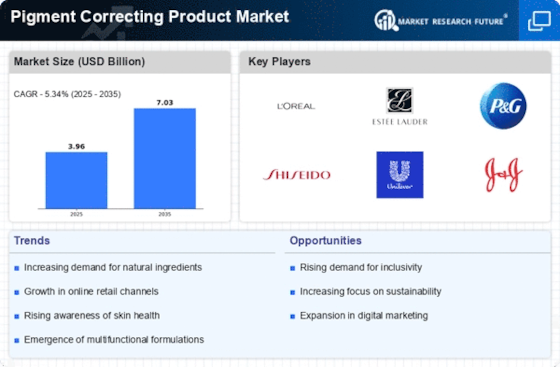Expansion of E-Commerce Platforms
The expansion of e-commerce platforms is transforming the retail landscape for the Pigment Correcting Product Market. With the increasing preference for online shopping, brands are leveraging digital channels to reach a broader audience. Market data reveals that e-commerce sales in the beauty sector have surged, with online sales projected to account for nearly 25% of total beauty sales by 2026. This shift allows consumers to access a wider range of pigment correcting products, often accompanied by detailed product information and customer reviews. As a result, brands are investing in their online presence and digital marketing strategies to capitalize on this trend, ultimately driving sales and enhancing brand visibility.
Increasing Awareness of Skin Health
The growing awareness of skin health among consumers appears to be a pivotal driver for the Pigment Correcting Product Market. As individuals become more informed about the effects of pigmentation issues, such as hyperpigmentation and melasma, the demand for effective solutions rises. This trend is reflected in market data, indicating that the pigment correcting segment is projected to grow at a compound annual growth rate of approximately 6.5% over the next five years. Consumers are increasingly seeking products that not only address pigmentation but also promote overall skin health, leading to a surge in innovative formulations. Consequently, brands are focusing on educating consumers about the benefits of pigment correcting products, thereby enhancing market penetration and expanding their customer base.
Influence of Social Media and Beauty Trends
The influence of social media and evolving beauty trends significantly impacts the Pigment Correcting Product Market. Platforms such as Instagram and TikTok have become vital channels for beauty influencers to showcase products that address pigmentation concerns. This visibility often translates into increased consumer interest and sales. Market data suggests that products endorsed by influencers can experience a sales increase of up to 30% within a short period. As beauty standards continue to evolve, consumers are more inclined to invest in products that promise a flawless complexion. This trend not only drives sales but also encourages brands to innovate and diversify their offerings, ensuring they remain relevant in a competitive landscape.
Rising Demand for Multi-Functional Products
The rising demand for multi-functional products is reshaping the Pigment Correcting Product Market. Consumers increasingly prefer products that serve multiple purposes, such as combining pigmentation correction with sun protection or anti-aging benefits. This trend is supported by market data indicating that multi-functional skincare products account for over 40% of the total skincare market. As consumers seek convenience and efficiency in their beauty routines, brands are responding by developing formulations that address various skin concerns simultaneously. This shift not only enhances consumer satisfaction but also drives brand loyalty, as customers are more likely to repurchase products that deliver comprehensive benefits.
Growing Interest in Sustainable and Ethical Products
The growing interest in sustainable and ethical products is becoming a crucial driver for the Pigment Correcting Product Market. Consumers are increasingly prioritizing brands that demonstrate a commitment to environmental sustainability and ethical sourcing. This trend is reflected in market data, which indicates that products labeled as sustainable or cruelty-free are experiencing higher sales growth compared to conventional products. As awareness of environmental issues rises, consumers are more likely to support brands that align with their values. Consequently, companies are reformulating their products to incorporate sustainable ingredients and eco-friendly packaging, thereby appealing to a conscientious consumer base and enhancing their market position.

















Leave a Comment